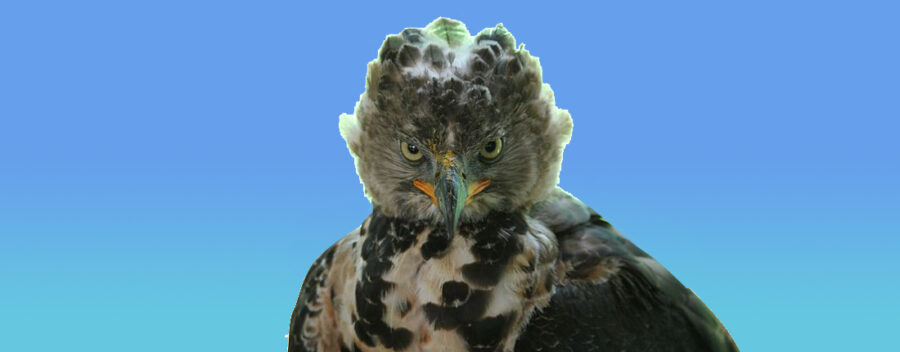
The crowned eagle, aka crowned hawk-eagle or African crowned eagle, has been dubbed “The most powerful eagle in Africa”. These raptors hail from central Ethiopia to as far south as Angola. Their preferred habitat is dense woodlands, rainforests, wooded cliffs, riparians, montane evergreen forests, forested ravines, open savannas, thornvelds, gorges, and rocky outcrops. They might be the most powerful, but the martial eagle is the largest eagle in Africa. Due to habitat loss, hunting, and trapping, these beautiful eagles are listed as Near Threatened by the IUCN. Their estimated numbers are up to 50,000 but those numbers are decreasing.
First the Stats…
Scientific name: Stephanoaetus coronatus
Weight: Up to 10 lbs.
Length: Up to 3.2 feet
Wingspan: Up to 5.9 feet
Lifespan: Up to 15 years
Now on to the Facts!
1.) African tribesmen highly value the head (crown) feathers of these eagles.
2.) Crowned eagles prey on chevrotains, duikers, rock hyrax, small primates, reptiles, mongooses, feral cats, rats, and birds.
3.) These eagles are also considered 1 of the loudest eagle species.
4.) Males make a shrill kewee-kewee-kewee sound, while females make a lower kooee-kooee-kooee sound. Females and chicks both also produce a high-pitched kwee-kwee-kwee call.
5.) When hunting in pairs, the male will fly over the treetops, while the female gets close to their primate prey. While the confused monkey is watching the male, the female swoops in for the kill.
But wait, there’s more on the crowned eagle!
6.) These eagles are monogamous (mate for life).
7.) Females lay up to 2 eggs that hatch in up to 49 days.
Did you know…?
Not only can the crowned eagle swoop down at prey, in mid-air, at 100 mph but they can also stop within 20 feet!
8.) In the event that 2 eggs are laid. The first born will always out-compete the youngest for food, forcing it to starve to death.
9.) When a prey item is obtained, the attacking eagle will use it’s powerful talons to break the spine of its prey. Then they will carry it to their nest for consumption.
10.) The chick’s crown feathers show up after about 2 months of age.
But wait, there’s more on the crowned eagle!
11.) Male eagles have been seen flying at over 6,600 feet elevations. That is equal to most cloud lines.
12.) Due to their interesting wing shape, they are almost silent in flight, like an owl.
Did you know…?
The crowned eagle has been presented before as the only bird in a list of the 10 strongest living land creatures – pound for pound.
13.) These eagles are non-migratory.
14.) As if they have much to worry about, these birds of prey are typically nervous, constantly alert, and seem on edge.
15.) Male crowned eagles tend to be fearless towards humans and will even show aggression towards an approaching human.
Now a Short Crowned Eagle Video!
Be sure to share & comment below! Also, check out the Critter Science YouTube channel. Videos added frequently!
Want to suggest a critter for me to write about? Let me know here.



